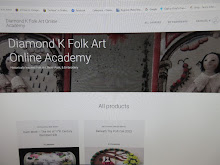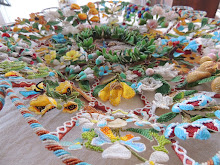Solid & Spun Glass....I wouldn't Recommend for Eating....
The last set of birds in the set are beautiful pink 'somethings'.. I have no idea what, but aren't they pretty? Both are set high atop blue & pink colored pedestals~ one on short feet, the other on rather tall very fragile legs~ they lean to the back a little sitting on a hard surface, but plunged down into a cake, could be positioned so the bird is perfectly vertical. See their long tail 'feathers'...that's spun glass!The most beautiful, I assume the male, has a gorgeous dark brown breast.
Each of the birds' tails have three blown holes that the spun glass has been inserted into. Think of angel hair on your Christmas Tree...it does shed a little....not exactly something you would want as a decor on an edible cake..
The pedestals are both decorated with little pink roses~ this one has fancy feet that match the feet of several other pieces. You can see that the glass from his tail nearly touches the ground!
I think the next two most amazing! Their long glass spikes have not been broken off. (And no, it is not simply the glass rod they were made on, it is an actual spike that tapers to a point at the end). Each has a pink glass basket overflowing with fauna and pink & blue roses underneath an arbor of glorious meticulously shaped cobalt blue glass. This one is sadly missing it's figure~
But this one is not~ it still retains a beautiful and absolutely cunning lampworked cupid holding a bow in one hand and arrow in the other. I so wish the other one was not lost~ one can see where its feet once stood, little white stumps sticking up...I wonder what it was!
Lampwork is the term used to describe the method used to make glass works such as these. It has been around since the 1400's~ A worker would sit at a table with an oil burning lamp that had either a bellows underneath of it or a tube he could blow into to direct his breath toward the flame to make it burn hotter. Rods of glass were held into the flame until they melted to the right temperature, and then he would form them into figures and all sorts of fanciful things. 16th and 17th c lampwork figures commonly are built up over a wire stick form, with some of the rods of glass even containing minute wires of copper within them to give the figures strength. (None of my pieces have any wire in them). It is quite amazing if you consider that todays lampworkers use acetylene fired torches!
ohhhhh to have been there and have gotten to watch how they were made~ what a dream that would be!




























3 comments:
Oh! those glass fiber tails are amazing and they may go some way towards dating this set...I looked up 'fiber glass' on Wikipedia and discovered that it was being made in the late 19th c. - but Owens Corning invented the more common form in the 1930's...no matter what the exact date of these lampworked cake decorations...they are gorgeous and I really appreciate your sharing them with us!
Elisabeth in CT (from CoC)
Thanks for visiting Elisabeth! Yes spun glass was made in the late 1800s~ provenance on my pieces date to 1840, but it is not known if they were made at that time, or earlier. The glue attaching the spun glass is an animal base glue, probably dating to the late 1800s as well. I think perhaps the birds could be pink egrets, (and could have had actual long tail feathers originally inserted into the holes in their tails)... but the brown marking on the males chest doesnt match an egret!
Just gorgeous Rachael, you sure are one lucky gal having the opportunity to add these gorgeous works of art to your collection...stunning!
Post a Comment